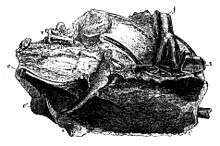Lithornis
| Lithornis Temporal range: Paleocene-Eocene, 56–40 Ma | |
|---|---|
 | |
| Woodcut of the L. vulturinus holotype | |
| Scientific classification | |
| Kingdom: | Animalia |
| Phylum: | Chordata |
| Class: | Aves |
| Clade: | Notopalaeognathae |
| Order: | †Lithornithiformes |
| Family: | †Lithornithidae |
| Genus: | †Lithornis Owen, 1840[1] |
| Species | |
|
Lithornis celetius | |
Lithornis is a genus of extinct paleognathous birds. Lithornis were able to fly well, but are closely related to today's tinamous (which are poor flyers) and ratites (which are flightless birds).
Fossils of Lithornis are known with certainty from the Upper Paleocene through the Middle Eocene, but their fossil record may extend to the late Cretaceous. "Lithornis" is from ancient Greek for "stone bird", as it is one of the first fossil birds to become widely discussed. Presumably closely related genera are Paracathartes and Pseudocrypturus.
Species
Six species have been recognized in modern times; undescribed ones are also likely to exist. The supposed tarsometatarsus piece from which "Lithornis" emuinus was described is actually a humerus fragment of the giant pseudotooth bird Dasornis.[2]
Lithornis vulturinus
L. vulturinus was described as a vulture by Owen (1840) from the holotype fossil 955 738 - TM 024 717. The fossil was collected from Early Eocene London Clay deposits on the Isle of Sheppey, Kent, England by J. Hunter before 1793. This fossil was destroyed by bombing in World War II. Numerous isolated fossil bones of Lithornis vulturinus were incorrectly described anew, such as Parvigyps praecox and Promusophaga magnifica - the supposed earliest vulture and turaco, while others were referred to existing families of neognathous birds. A neotype (BMNH A 5204) was erected to replace the holotype in 1988 by Houde, who for the first time diagnosed it as a paleognath based on complete three-dimensional skulls and skeletons of congeners from North America. An exceptionally preserved specimen was collected from Denmark and cataloged as MGUH 26770.[3]
Lithornis hookeri L. hookeri was first described by Harrison (1984) as a rail Pediorallus.[2][4]
Lithornis nasi
L. nasi was described by Harrison (1984) as a rail Pediorallus,also.[2]
Lithornis celetius
L. celetius is from the Bangtail Quarry, Sedan Quadrangle, Park County, Montana, USA, and was described by Peter Houde (1988). It is from the Fort Union Formation, which is earliest Tiffanian, Late Paleocene. The type fossil is USNM 290601.[2]
Lithornis promiscuus
L. promiscuus has type specimen USNM 336535 and was described by Peter Houde (1988). It is from the Clark Quandrangle, Park County, Wyoming, USA. It is from the Willwood Formation, which is earliest Eocene in age. An egg, USNM 336570, is known for L. celetius as well.
Lithornis plebius
L. plebius is from the same locality as L. celetius and was also described by Peter Houde (1988). The type specimen is USNM 336534.
References
Footnotes
Sources
- Hinton, A. C.; Lang, W. D.; et. al (1939). Neave, Sheffield Airey, ed. Nomenclator Zoologicus. 2. Regents Park, London: Zoological Society of London. p. 975.
- Houde, Peter (1988). "Paleognathous Birds from the Early Tertiary of the Northern Hemisphere" (pdf). Publications of the Nuttall Ornithological Club. Cambridge Massachusetts, USA: Nuttall Ornithological Club. 22: 34–35.
- Leonard, Leona; Gareth J. Dyke; Marcel Van Tuinen (October 2005). "A new specimen of the fossil palaeognath Lithornis from the Lower Eocene of Denmark". American Museum Novitates. 491 (3491): 1–11. doi:10.1206/0003-0082(2005)491[0001:ANSOTF]2.0.CO;2.
- Mayr, Gerald (2008). "First substantial Middle Eocene record of the Lithornithidae (Aves): A postcranial skeleton from Messel (Germany)" (pdf). Annales de Paléontologie. Elsevier Masson SAS. 94: 29–37. doi:10.1016/j.annpal.2007.12.004. Retrieved Jan 18, 2010.